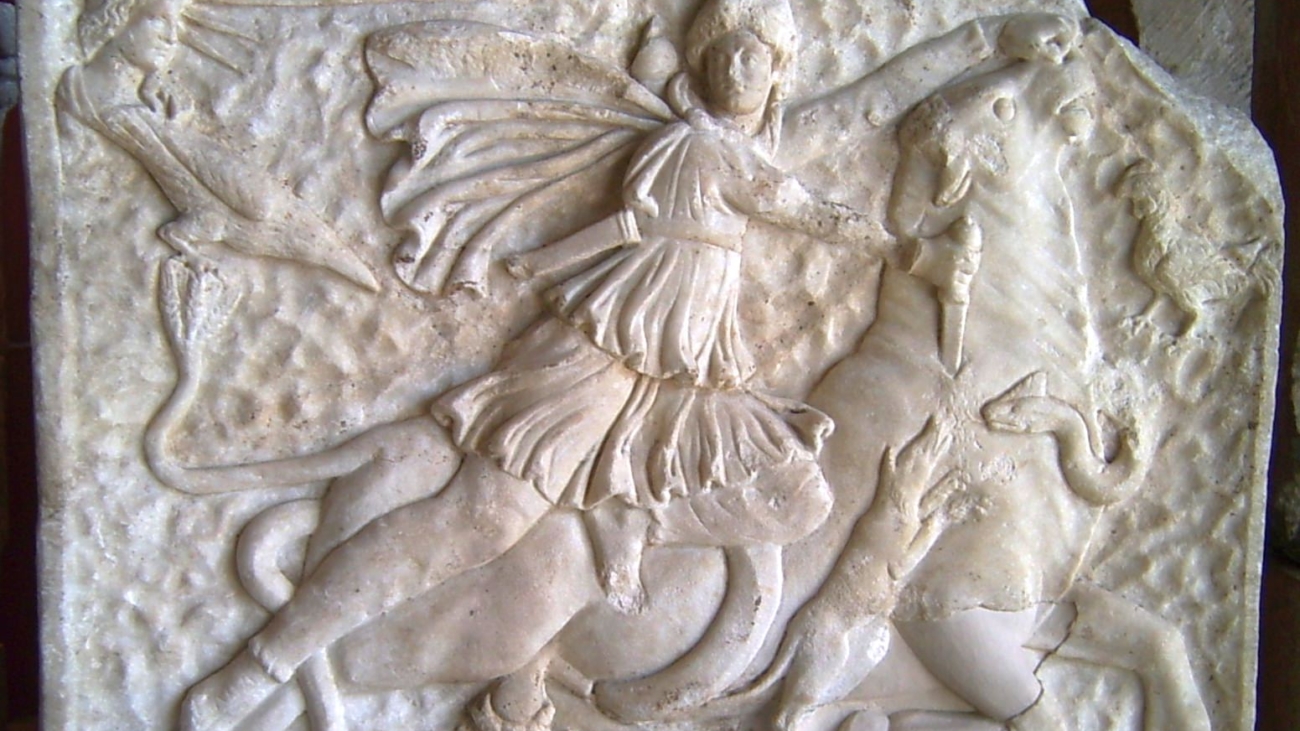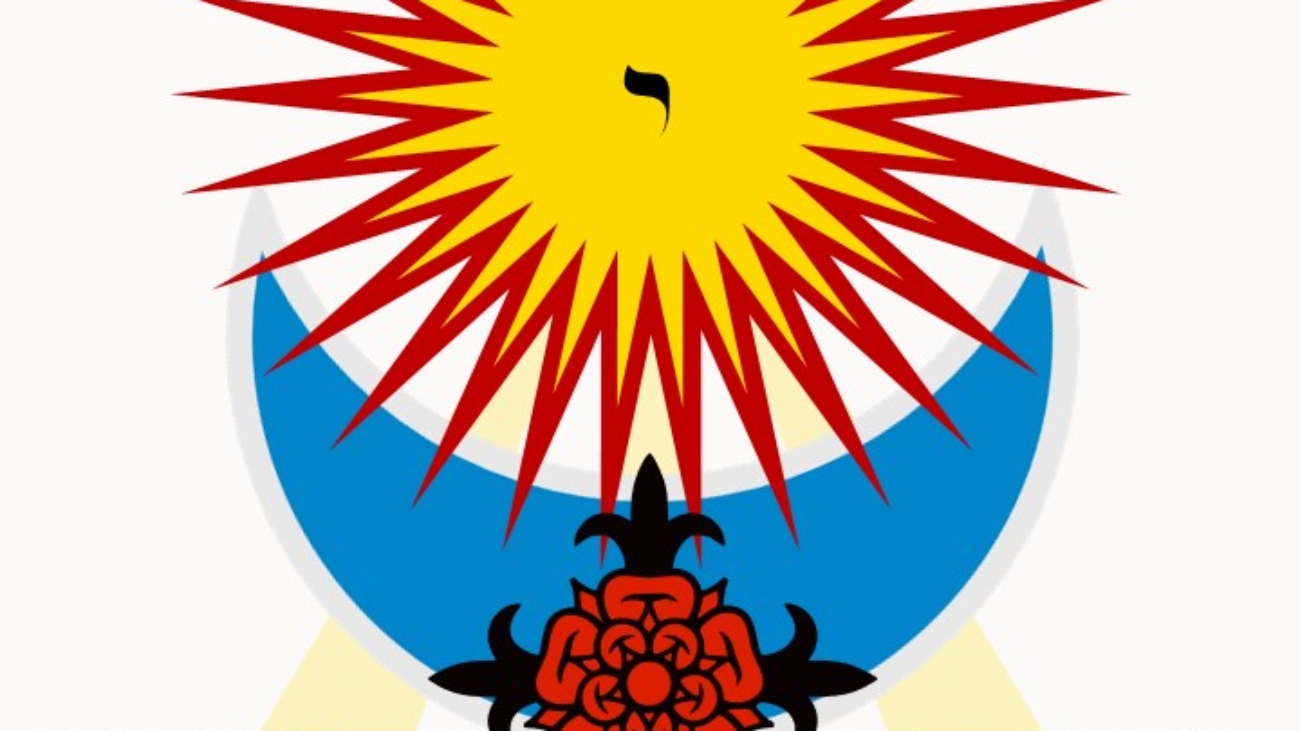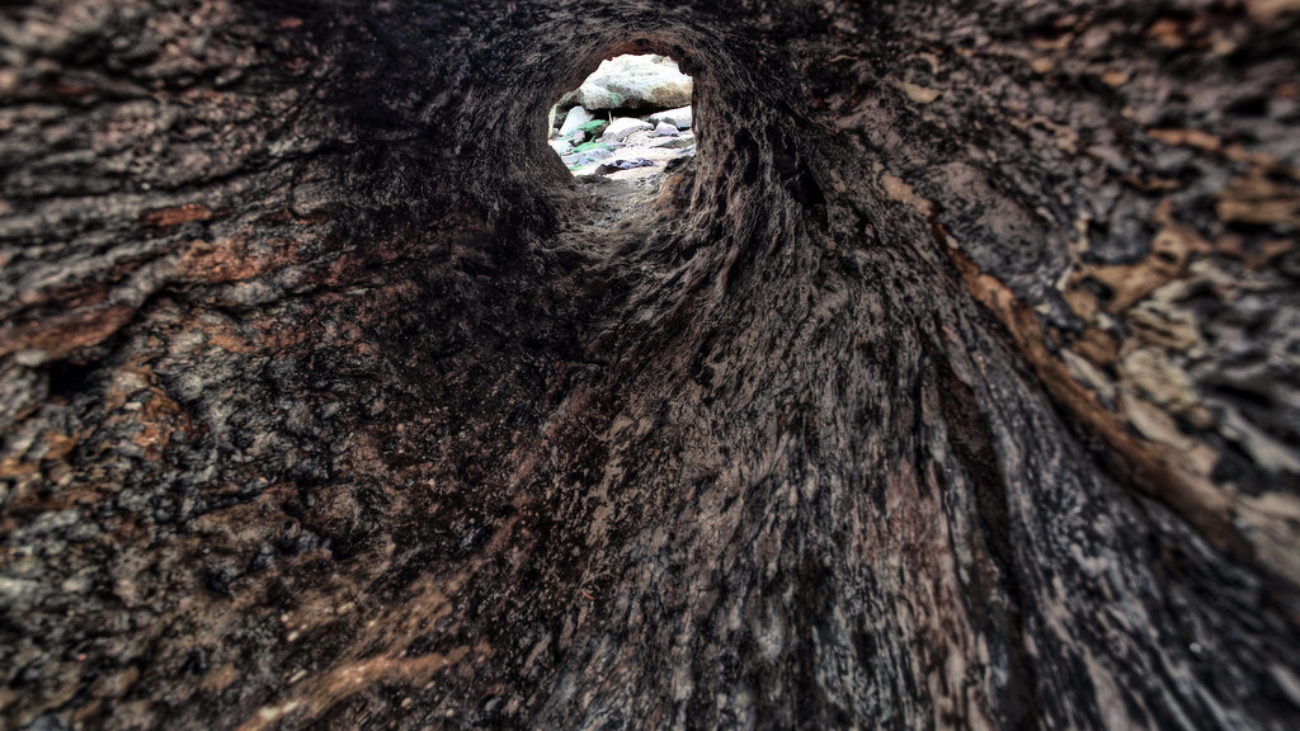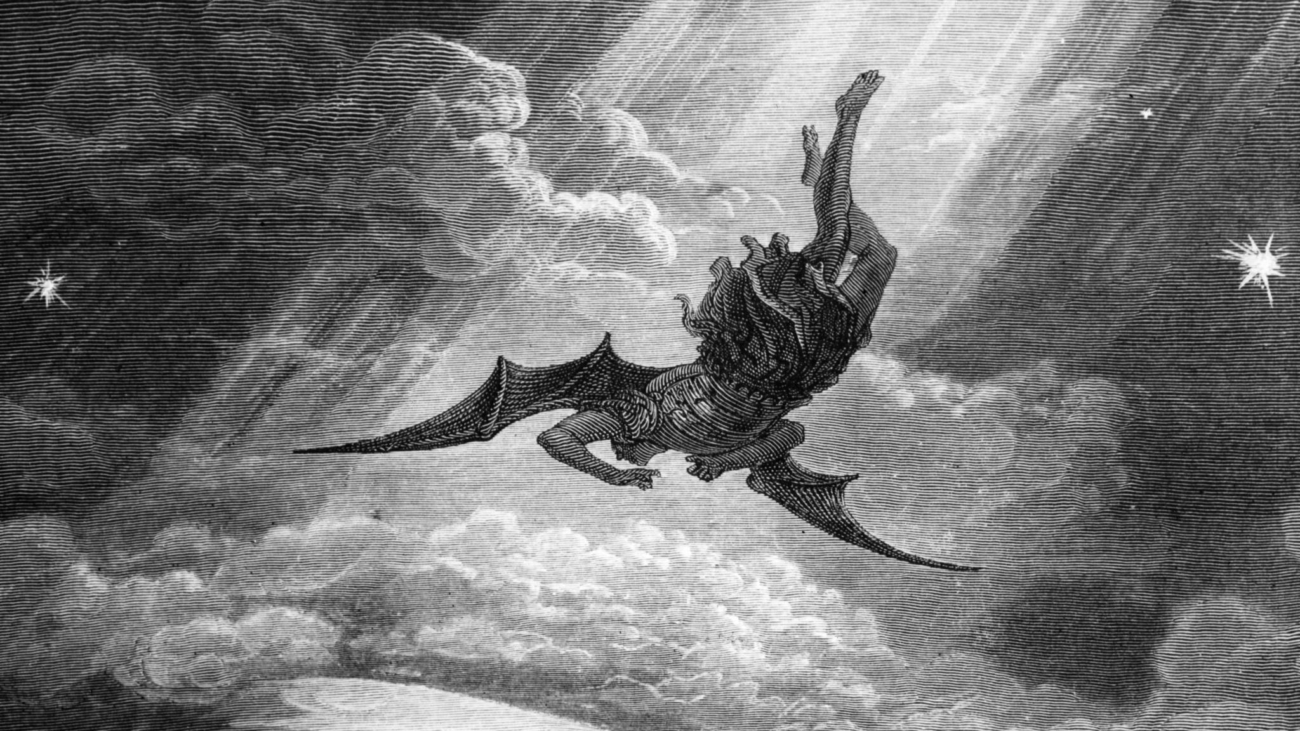One of the reasons Crowley’s project with OTO is so often misunderstood is because it is an implementation of Thelema as a mystery religion, and we don’t really have a category for that in modern spirituality.
The Secrets of the Mysteries
The flower of mystery is the deep understanding of one’s identity with God. To eat its fruit is to savor immortality.
Kenosis and Agape in Thelemic Mysticism
Until we have properly cultivated love, the extremes of Thelemic magical and mystical experience remain off-limits.
O.T.O. and Orthodoxy
There are two problems I see with the view that O.T.O. should not teach an orthodoxy.
Thelema and Secularism
The idea that truth—spiritual or otherwise—reduces to personal truth isn’t “Thelemic” per se. It’s just secularism. That’s one of the defining stroke of the secularist worldview.
Dignity and Divinity
One of the recurring motifs of Gnosticism and Hermetism is the idea that the soul is God or a divine spark which has accidentally fallen into and become ensnared in matter. This means incarnation is a tragedy or mistake in which we lose our divinity which must be rectified through gnosis and return to the divine source or pleroma.
By contrast, Thelema teaches that there is no fall, there is no mistake which must be rectified. We are God before incarnation. We are God during incarnation/birth. We are God as we live. We are God as we experience joy. We are God as we experience misfortune. We are God as we experience loss. We are God as we experience sickness. We are God as we die. We are God after death. (See NC on AL I.8, NC on AL I.29, and the rituals of initiation of O.T.O. O°-P.I.)
The question then is not, “How do I recognize my divinity so as to return to ‘The Source’?” but rather “How do I come to the recognition of my divinity so as to enjoy each and every one of these moments of becoming as a God would?” The method of achieving this is taught in the Lesser Degrees of O.T.O., but in a word we might say it is by seeking balance.
But never mind the method. What does it even mean to be God in this life?
As an entry point into this idea, it might be useful to substitute the phrase “to be God in this life” with the phrase “to have dignity in this life”. It’s not possible to avoid misfortune, including death, but it is possible to act with dignity in the face of misfortune.
Dignity means “the state or quality of being worthy of honor or respect”.
In other words, by your own standard, can you respect the way that you act in challenging situations? Are you the sort of person that you yourself would look up to? If you were facing a challenge, are you the sort of person you would turn to for help? Can you count on or depend upon yourself?
Almost any terrible situation can be made worse through dishonorable, undignified behavior. As bad as misfortune can be, it is also possible to aim down instead of aiming up, thereby making things worse for everyone. If you can’t rely upon yourself in a difficult situation, it’s likely other people can’t, either (and vice versa).
If you often find yourself in this position where you’re not dignified, you’re not aiming up, and you’re not reliable or dependable—again, just by your own standards of the sort of person you’d want around when there’s a problem—then you should work on yourself. In particular you should work on your relationship with yourself.
Crowley taught that it is when we are most at unity with ourselves that the divine within us is able to shine through. You can take that to the extreme of mystical experience. (See Book of Lies, ch H and Magick, part 1.) But you should start at—and in my opinion continually return to—a basic level. If you can only experience yourself as God in states of mystical bliss, that’s a rather self-limiting expression of divinity. If you lose your divinity—or let’s say your dignity—as soon as you are low on money, have a fight with your spouse, lose your job, or get sick, then that’s not divinity worthy of the name.
Reflections on the Path in Eternity (Part 1)

I was recently inspired to create an animated movie based upon my understanding of the Path in Eternity and its relation to certain magical formulae.
The phrase Path in Eternity comes from a passage in Magick Without Tears where Aleister Crowley is describing the initiation rituals of the Man of Earth degree of Ordo Templi Orientis.
Let us begin at the beginning. What is a Dramatic Ritual? It is a celebration of the Adventures of the God whom it is intended to invoke. (The Bacchae of Euripides is a perfect example of this.) Now, in the O.T.O., the object of the ceremonies being the Initiation of the Candidate, it is he whose Path in Eternity is displayed in dramatic form.
Magick Without Tears, Chapter 13, The System of the O.T.O.
He then describes this Path in Eternity in relation to the six sub-degrees of the Man of Earth in the following way:
- O° – Minerval – The Ego is attracted to the Solar System.
- I° – Initiation – The Child experiences Birth.
- II° – Consecration – The Man experiences Life.
- III° – Devotion – He experiences Death.
- IV° – Perfection, or Exaltation – He experiences the World beyond Death.
- P.I. – Perfect Initiate – This entire cycle of Point-Events is withdrawn into Annihilation.
There are three important conclusions to draw here.
First, as in the mystery schools of the ancient world, the purpose of O.T.O. initiation—in particular, this series of six sub-degrees that comprises the Man of Earth—is to introduce a single individual or candidate to a single god. The main difference between the O.T.O. initiations and those predecessor schools is that in O.T.O., the god the candidate is being introduced to is none other than themselves. In Thelema, the term for this god—the divine part of each individual—is the Secret Self or Hadit.
Second, the purpose of the Man of Earth initiations is to dramatize the “path” taken by this god: a complete cycle in which the soul is drawn into incarnation, dies, and is withdrawn back into nothingness. The initiations are conducted in service to and with reverence toward that way of going which is characteristic of the Hadit which all of us truly is. The Path in Eternity is that toward which the entire series of rituals is oriented. The rituals derive their meanings from that Path.
Third, that path has a characteristic shape. It’s cyclical. It’s a passage from silence to speech and back to silence again. This is the exact same path as that taken by the Holy Guardian Angel which Crowley describes in Liber DCLXXI vel Pyramidos and which I quote at the beginning of the video:
For from the Silence of the Wand
Unto the Speaking of the Sword,
And back again to the Beyond,
This is the toil & the Reward.
This is the Path of HVA—Ho!
This is the Path of IAO.
So one of the first points I’m making in the video is that the Man of Earth series of initiations connects at a deep level with one of the core concepts of Thelema, namely, the idea of the Secret Self aka Hadit aka the Holy Guardian Angel.
The particular way in which it connects with that core concept is to show the characteristic going of that god, and to show how that way of going makes contact with an individual human life. In other words the conditions we find ourselves subject to—birth, aging, and death—are not incidental or exterior to our divinity. In fact they are necessary components of the way our divinity expresses itself.
This helps us begin to make sense of another one of the claims Crowley makes about these rituals:
The main objects of the instruction were two. It was first necessary to explain the universe and the relations of human life therewith. Second, to instruct every man how best to adapt his life to the cosmos and to develop his faculties to the utmost advantage. I accordingly constructed a series of rituals, Minerval, Man, Magician, Master-Magician, Perfect Magician and Perfect Initiate, which should illustrate the course of human life in its largest philosophical aspect. I begin by showing the object of the pure soul, “One, individual and eternal”, in determining to formulate itself consciously, or, as I may say, to understand itself.
Aleister Crowley, Confessions
This larger, universal context in which Crowley wishes to situate or orient the individual human life is the aforementioned Path in Eternity, which in turn is the characteristic way of going of Hadit.
Erotic destruction and IAO

One of the most interesting parts of Magick in Theory and Practice is chapter 20, “Of The Eucharist and the Art of Alchemy.” This chapter—particularly what Crowley says here about art production—was the subject of a talk I gave last summer for Horizon Lodge in Seattle.
In chapter 20 Crowley says that alchemy, initiation, talisman creation, art production (specifically painting, but the claim could be extended to other media), and eucharistic magick all share the same structure. There aren’t actually so many other types of magick besides those, so he’s presenting something like a unified theory of magick in general.
But even if that doesn’t cover every magical art, it still covers two areas that were of essential concern to Crowley: initiation and the production of the eucharist (which is a type of alchemy). The first is the primary subject matter of A∴A∴; the second is connected with the secret contained within the Sanctuary of the Gnosis of O.T.O.
My assumption was that if Crowley was talking about a structure essential to the essential work of both A∴A∴ and of O.T.O., he was describing something lying at the core of his spiritual project generally. What I claimed in my talk was that the magical formula which describes both of these processes is IAO.
IAO is the Golden Dawn formula of resurrection: Isis (Nature) is ruined by Apophis (the Destroyer) which is then redeemed by/as Osiris.
What I said in my talk, however, is that there is a shift in emphasis in Crowley’s version, because Apophis is no longer the ruiner of anything other than the false, initial appearance of nature. Through its destructive power, it frees or liberates what was latent, concealed, or in a sense trapped in the initial matter. It allows the “true self” latent within the first matter to transcend itself—to transcend its initial appearance—and to become part of a larger, vitalizing whole.
It doesn’t do this by discarding the matter necessarily but rather by turning it from resistance to persistence. Thus fire becomes the power of willing, water the power of daring, air the power of knowing, and earth the power of keeping silence. When they are in balance, thus arises the fifth power, going, attributed to Hadit.
In the process, change becomes expressive of will, thereby satisfying the postulate of magick. At the same time, because will is fully expressed in change—because matter no longer stands opposed to will but is its vehicle or “artistic medium”— it no longer has an existence independent of the universe. Hadit has become mystically enraptured with Nuit.
Thus there is a link between the work of Apophis in the IAO formula with love under will. Apophis represents destruction of separateness by love: the power of rebirth by voluntarily submitting to transformation.
Apophis is the spirit of erotic transcendence.
Gender series
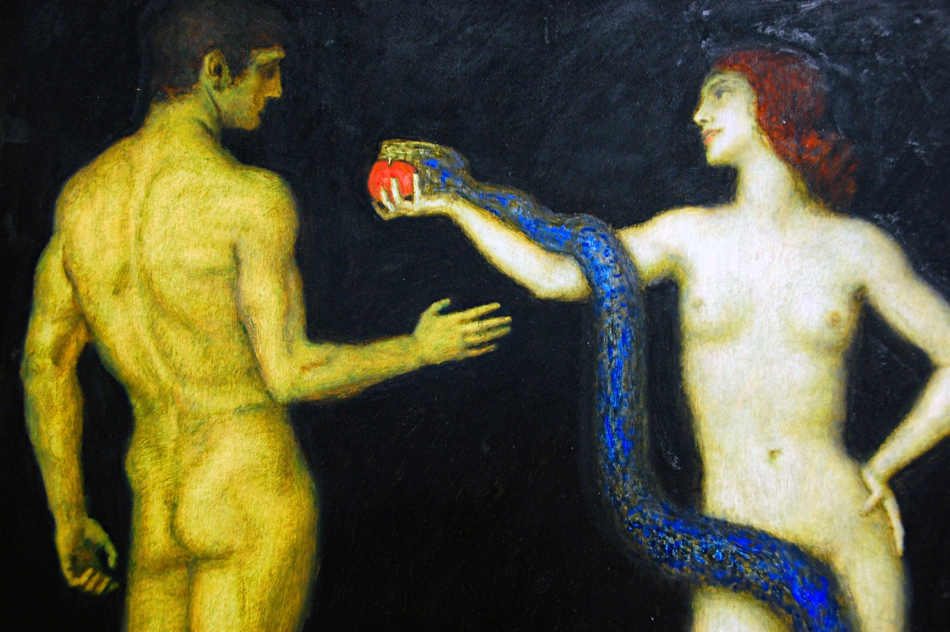
All of my recent writings on Thelemic/OTO theology as they relate to EGC gender policy can now be found grouped under the gender series tag.
Last month I wrote a series of posts on my private Facebook exploring Thelemic and OTO theology as it bears upon the Gnostic Mass and current EGC policy regarding gender. As these posts largely represented a process of research/discovery for me rather than finished products, I initially chose not to share them on my Lapis Mercurii blog. However, in retrospect, I think the process I went through—from questioning to considered opinion—might be valuable for other researchers and individuals questioning EGC policy.
- Questioning EGC policy on gender
- Questioning EGC policy or Thelemic theology is not “drama”
- Crowley on liberation, sexual freedom, and eucharist
- Biological reductionism and counterculture
- Why the outrage on the part of those in authority seems disingenuous
- Why Thelemites should develop competence in theology
- Solar-phallicism and EGC gender policy
tl;dr – The theology underlying OTO mystery—solar-phallicism—to my mind does not support transgender clergy or queer mass. In other words, EGC policy is already a lot more liberal than it ought to be if we were adhering to Crowley’s original intention. That being said, the theology itself is problematic and kind of gross, and current EGC policy at least represents a move in a direction where OTO can remain relevant. The main problem with the policy is that the church now occupies a middle position—a kind of no man’s land—where they must inevitably draw fire from every side. We’ve already deviated from the Blue Equinox model of OTO in countless ways. There seems to me to be very little gained by holding the line on this particular issue. If enby people want to serve as both Priest and Priestess, church authorities should just let them.
Balance and Imbalance on the Path
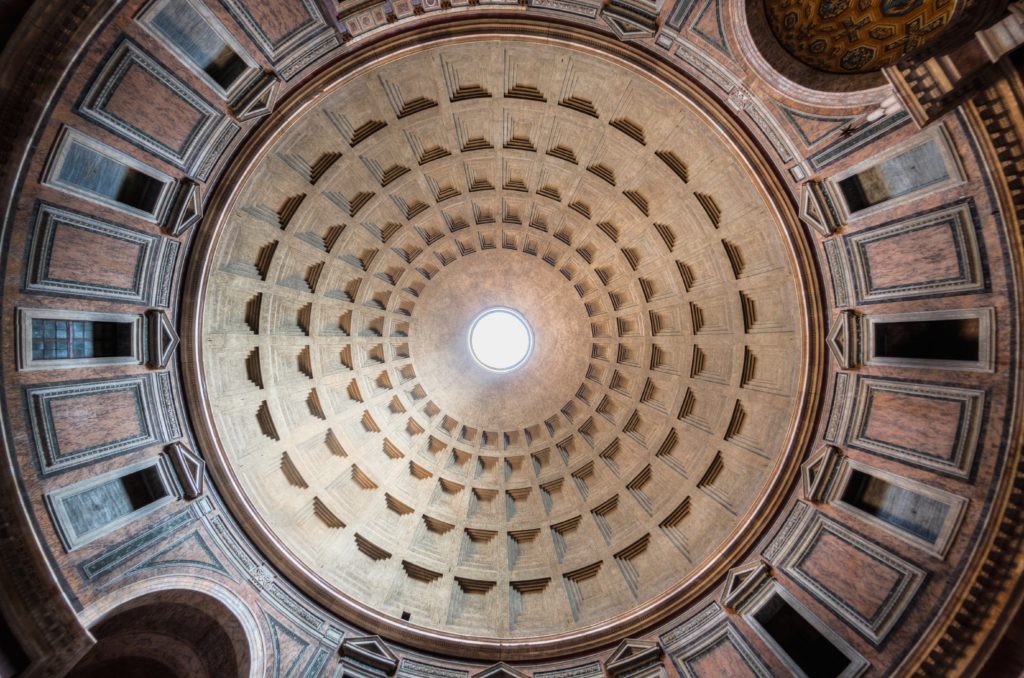
There’s this ancient temple in Rome called the Pantheon. It has a giant domed ceiling with a hole right in the center of it. I visited it in my 20s. I think “grand” is the right word to describe it. It’s not easy to capture in a photo.
When I think about the relationship between magick (especially theurgy) and mysticism, I recall what it was like looking up at the ceiling of the Pantheon from inside. I imagine the flower of the rose-cross painted on the ceiling, the opening in the middle being where the central cross would be. The multi-colored petals would be painted around the hole.

Whether you’re practicing theurgy or yoga, you’re aiming up in both cases. It’s just a question of how you aim. When you unite yourself with some particular god or goddess—or if you’re just working with some particular path—that’s aiming toward one of the petals off to the side of the central opening. But yoga is like aiming in a direct, vertical line through the hole in the roof.
Of course that’s exactly how Crowley thought of Knowledge and Conversation of the Holy Guardian Angel as well. The Holy Guardian Angel is on the middle pillar of the Tree of Life.
The magician devotes himself entirely to the invocation of a God, and as soon as his balance approaches Perfection he ceases to invoke any partial God; only that God vertically above him is in his path. And so a man who perhaps took up magic merely with the idea of acquiring knowledge, love, or wealth, finds himself irrevocably committed to the performance of the great work.
Magick in Theory and Practice, Chapter 15
I shoot up vertically like an arrow, and become that Above. But it is death, and the flame of the pyre. Ascend in the flame of the pyre, O my soul! Thy God is like the cold emptiness of the utmost heaven, into which thou radiatest thy little light. When Thou shall know me, O empty God, my flame shall utterly expire in Thy great N. O. X.
Liber VII, I.37-40
The O.T.O. IX° working is also a middle pillar working. It is attributed to the path of Samekh, the path uniting the Sun (Tiphareth) with the Moon (Yesod). Its hieroglyph depicts a Lion and an Eagle exchanging their essences into a cauldron. The Caput Mortuum drops to the bottom of the cauldron as spiritual air (Aleph, Baphomet) rises. This rising spiritual current is the “Rashith-ha-Gilgalim of the new Universe created of the Quintessence of the Substance of the Unity of the Angel and the Adept, expressed therefrom by virtue of ‘love under will’ at the moment of Rapture.” (Commentary on LXV V.1) This is the spiritual essence unlocked from the Eucharist of One Element, the Medicine of Metals. It is like a cosmic stem cell which can be molded into any physically possible state of affairs by the magician.
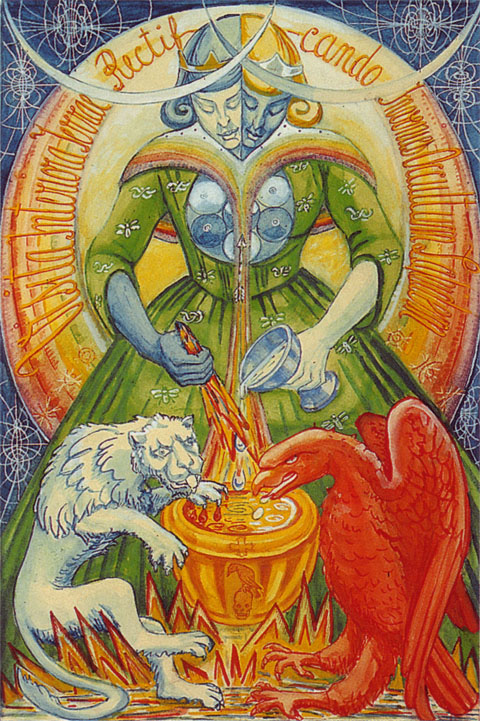
In other words this issue of working the middle pillar applies both to the Knowledge and Conversation of the Holy Guardian Angel as well as the IX° magick. It applies to the mysteries of both A∴A∴ and O.T.O.
This mystery is represented analogously in the Gnostic Mass. Here it is depicted using a eucharist of two elements rather than one. The Priestess is like the Angel of the Priest, and the “moment of rapture” is symbolized when they cry HRILIU.
Another way to put it is that in the case of yoga, one aspires up the middle pillar, but in this particular kind of magick, one manifests a current down the middle pillar (into the organs of generation, which are represented on the Tree of Life by Yesod). Generally speaking, magick is a movement of energy “down the Tree”. The impulse originates with the Will in Chokmah and is given form on the astral at Yesod before manifesting in Malkuth. Yoga, theurgy, and path workings tend to be ascensions “up the Tree”. Both operations (yoga and magick) require mastery of the subtle energetic currents represented by the entire Tree of Life, though.
It’s a commonplace to talk up “balance” in relation to Crowley and Thelema, but it really is an essential theme. “Balance” will mean different things to you at different points of your spiritual development. There’s balance of the elements within your conscious experience. There’s a balance point or borderline between conscious and unconscious which has to be worked with more or less interminably. There’s contrasexual balance points.
What happens typically is that you experience a “calling” into some terra incognita. This might be an entirely new calling, or it might be some perennial difficulty in your life. But it will draw out what Jung called a complex. The easiest way to describe a complex is that you just don’t feel like yourself anymore. You feel like you’ve temporarily become a different person. If you are usually self-controlled, you’re suddenly impulsive. If you’re usually strong, you’re suddenly clingy and weak. If you’re usually kind, you’re suddenly sadistic. And then you have to work with that imbalance in order to get yourself back to a place of balance.
God is above sex; and therefore neither man nor woman as such can be said fully to understand, much less to represent, God. It is therefore incumbent on the male magician to cultivate those female virtues in which he is deficient, and this task he must of course accomplish without in any way impairing his virility. It will then be lawful for a magician to invoke Isis, and identify himself with her; if he fail to do this, his apprehension of the Universe when he attains Samadhi will lack the conception of maternity.
Magick in Theory and Practice, Chapter 1
In my opinion, Crowley’s description of this process here is perfunctory, even blithe.
In any case, there’s really no formula for this. I’m not even going to try to offer “helpful hints” on it. But generally speaking, that’s the work of magick or going “off-center” as I described above.
